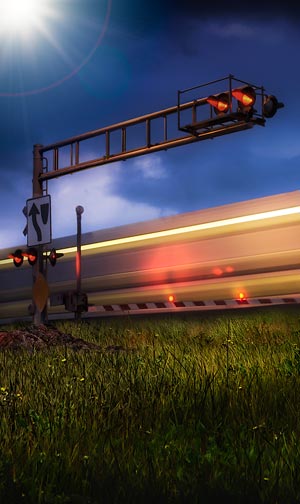One Killed and Another Injured at Non-Gated, Sun-Blinded Indiana Crossing
(Jeffersonville, Indiana – March 3, 2018)
Residents of the small southern Indiana town of Jeffersonville, north of Louisville, KY, were complaining about signal placement and integrity after a CSX freight train travelling on tracks of the Louisville & Indiana Railroad struck an auto at the non-gated crossing of Coopers Lane. The collision killed one occupant and sent the other to the University of Louisville Hospital with serious neck injuries about 4:35 P.M. Friday afternoon.
Neither victim was identified by law enforcement officers by name, residence, age, gender or which one was the driver and which one was the passenger in the tragic collision.
Tom Cartwright of Charlestown, IN, a motorist driving on U.S. Highway 31, which closely parallels the railroad track, told News & Tribune Writer Elizabeth DePompei that he witnessed the train strike one car (the victims’), sending it careening into a second vehicle, an SUV. Mr. Cartwright immediately called 911. He noted that there are no crossing arms at the intersection where the crash occurred, and could not verify whether the crossing lights were flashing.
But Bill Gibson, who works right next to the C&I tracks, could tell WAVE-TV, News Channel 3 in Louisville’s Sharon Yoo that the road/rail crossing is “a bad intersection,” citing Friday evening’s tragedy as at least “the third time it has happened.”
According to statistics kept by the Federal Railroad Administration, it was the 10th crash between trains and highway vehicles. The death of the driver involved in this collision was the second to be suffered there. The FRA’s railroad crossing database further said that, on an average day, eight L&IRR and CSX freight trains cross Coopers Lane at speeds up to 49 mph.
Gibson told WAVE’s Yoo that it was “a recipe for disaster.”
“The lights are facing the wrong direction,” he told WAVE News, adding that “There should be those auto-arms (crossing gates) that come down.” He further explained that “especially around sundown, the lights are even harder to see because the sun blazes in the faces of drivers headed west on Coopers Lane.”
Gibson had crossed the tracks himself, only four cars ahead of the one which was struck, saying “I didn’t see the lights myself until I was literally on the tracks, and I was like ‘oh! I gotta go.’ I could see the train coming.”
“There are no bells dinging,” Gibson added. “At other crossings, I’ve heard bells and (seen) arms that come down. There’s none of that here!”
“Something needs to be done,” he concluded.


